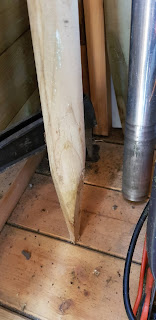Autumn fruiting raspberries are great. You just chop them down in ground level in February and they grow again, giving you lots of lovely fruit year after year (in my case in late July and August) with very little further effort. You don't even need to support them. But, if like me, you are growing them right next to a path and/or the doors to the greenhouse and/or shed, you might want to, as otherwise they do tend to scratch at you as you walk past.
In previous years, we have used bamboo canes with string tied around them to try and keep the raspberries in. But the raspberry canes have proven stronger than the canes. So what we've now done is buy wooden stakes. The wooden stakes were approximately 180 cm long with pointed tips, so we could bash them more easily into the ground.
We used a mallet to drive them about 30 cm into the ground and then tied string around them at three heights to keep the raspberries in. We actually did it while the raspberries were almost ready to fruit, but doing it before they grow is probably more sensible.













